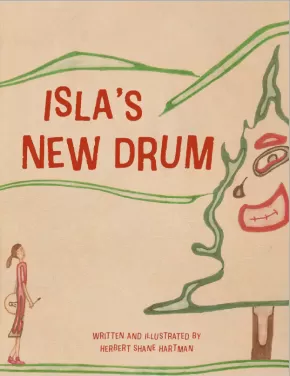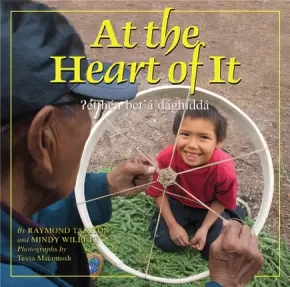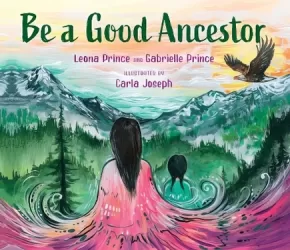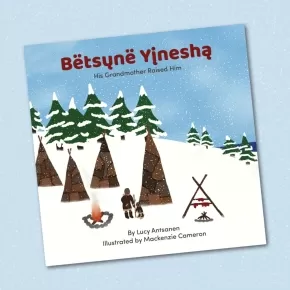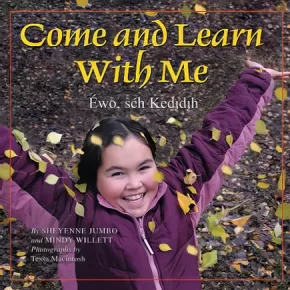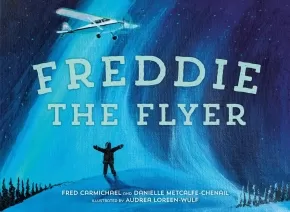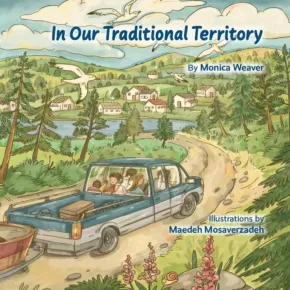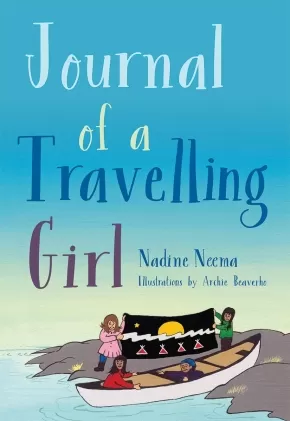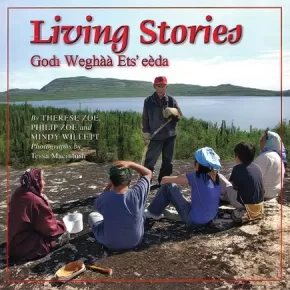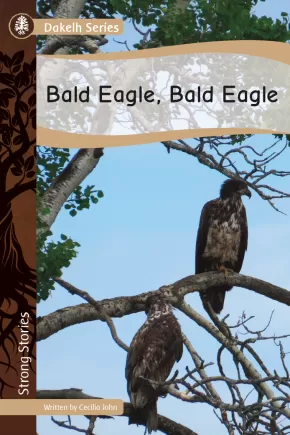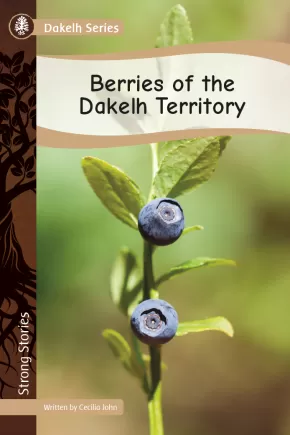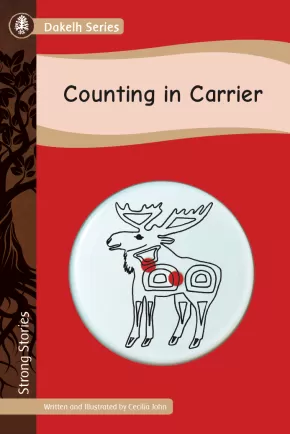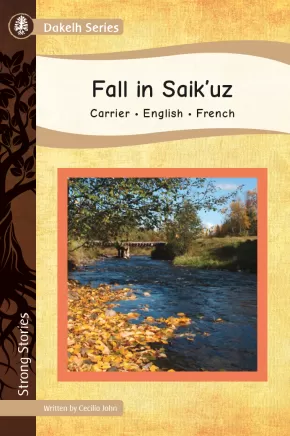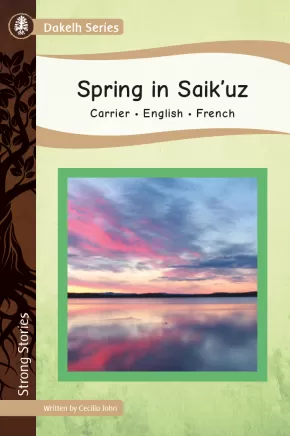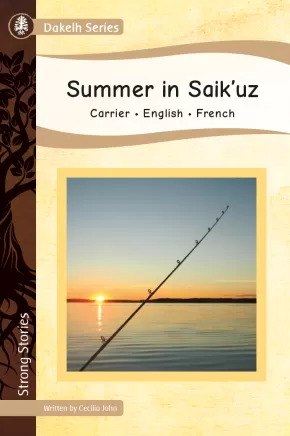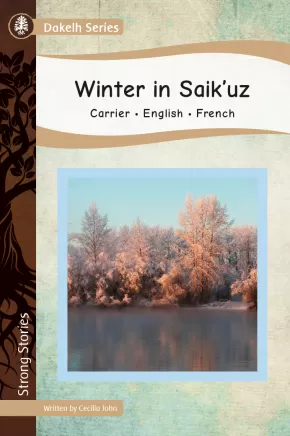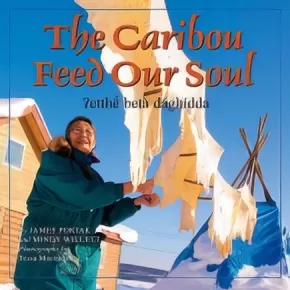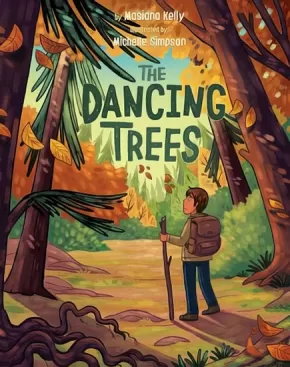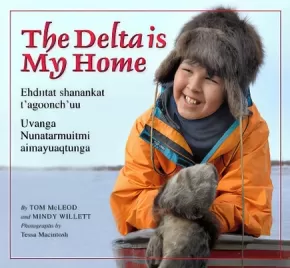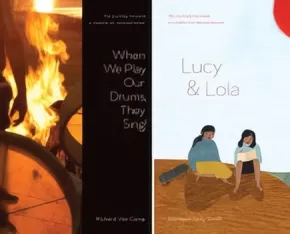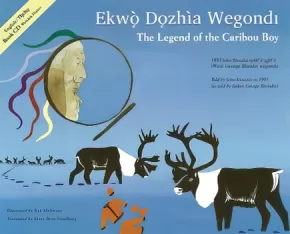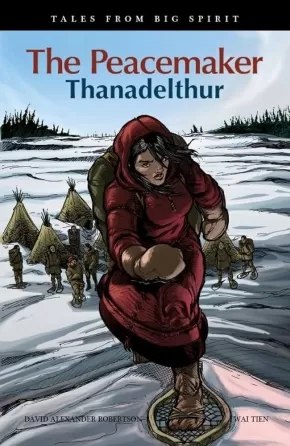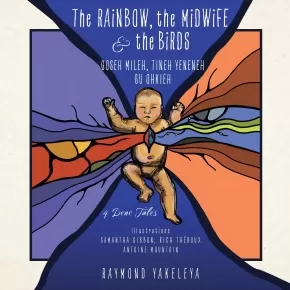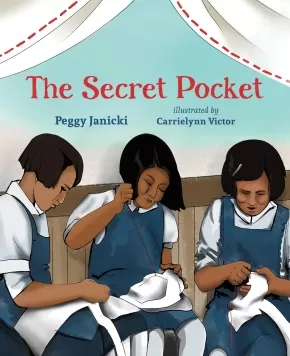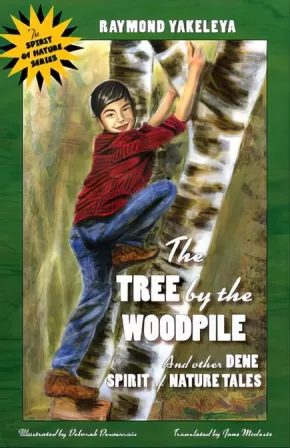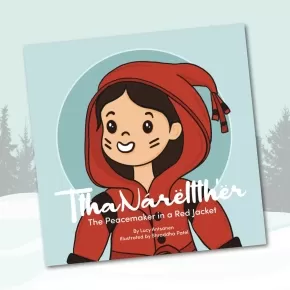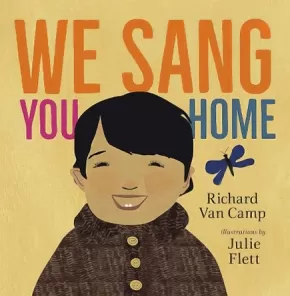
Theme Bundle: Dene Resources for Elementary Students
$563.91
Text Content Territories:
Indigenous Canadian; First Nations; Dene;
Status: Available
Other Categories:
Strong Nations Bundles | Elementary Bundles | Culture / Community | Indigenous | First Nations | Custom Bundles
Details:
This bundle includes Dene resources for elementary students. A few books for preschool students and toddlers are also included. Some books share Dene stories, while others are by Dene authors or illustrators and may not contain Dene-specific content.
Resources that become unavailable (in reprint or out of print) will not be included in the bundle. To view what is currently included in this bundle, please scroll below.
● The listed materials for this bundle
can be purchased as a full bundle or separately. To purchase the full bundle click on the "Add to
Basket" button above (the first one on this page).
● To purchase items individually, click the "Add to Basket" buttons below, beneath the individual
item titles.
Dene Resources for Elementary Students
FLASH SALE! Isla's New Drum
 $9.38 $12.50
$9.38 $12.50

Format:
Paperback
Text Content Territories:
Indigenous Canadian; First Nations; Dene; Dakelh (Carrier); Nak’azdli Whut’en;
ISBN / Barcode: 9781771745574
Synopsis:
Synopsis:
Isla’s New Drum is Shane Hartman’s debut children’s book. The story is a contemporary story that Shane wrote for his daughter after he had made her a drum and gifted it to her. Isla loved her new drum!
Isla has been given a new drum that she loves dearly but she doesn’t have a song to sing to her new drumbeat,
Boom ba ba boom
Boom ba ba boom
Boom ba ba boom boom
So, Isla decides to ask some forest friends to help her make a new song. Each friend offers Isla what they can, showing true generosity. Each friend also offers a message that is important to keeping Mother Earth healthy and strong. In return, Isla plays her drum for each friend as she gives back what she can. Isla discovers so much more than her new song!
Educator Information
The Dakelh (Carrier) words included in this book were referenced from The Central Carrier Bilingual Dictionary. The Carrier Language belongs to the Athapaskan language family and has three major dialects: Northern - Babine Lake, Central - Stuart lake, Southern - locations as far south as Anahim Lake.
Keywords / Themes: Drum; Indigenous Canadian, Environmental Awareness, Friendship, Music; Nak'azdli Whut'en.
Recommended for Preschool - Grade 1
Additional Information
32 pages | Colour illustrations | 8.5" x 11" | ISBN: 9781771745574 | Paperback
A Dance Through the Seasons
$20.95
Artists:
Format:
Paperback
Text Content Territories:
Indigenous Canadian; First Nations; Dene; Dakelh (Carrier);
ISBN / Barcode: 9781777894740
Synopsis:
Synopsis:
Young Woman, like many people her age, is full of curiosity, energy and strength. What happens when people around you don’t recognize that strength?
This story is about the journey of Young Woman and Turtle. They move through the seasons together and Young Woman learns that growing up takes patience and time. Leadership comes from within, but it also comes from listening to the world around you.
A Dance Through the Seasons not only leads you through the story of one girl’s path, but also through the seasonal rounds of the Dakelh (Carrier) people of British Columbia.
Educator Information
The inspiring A Dance Through the Seasons is told through story and cultural teachings by award-winning Dakelh educator Leona Prince, with dream-like illustrations from acclaimed Cree and Métis artist Carla Joseph.
Readers of all ages will admire Young Woman as she endures and learns from each of the four seasons using many traditional means. Like Young Woman, we all have something to learn – from nature, the seasons, and our Elders, when we recognize and trust in our guides.
Find all of the hidden turtles in each illustration as they guide you through her journey.
This is the second edition.
This book is available in French: Une Danse au Fil des Saisons.
Additional Information
56 pages | 11.00" x 8.50" | Paperback | 2nd Edition
Aggie and Mudgy: The Journey of Two Kaska Dena Children
$14.95
Format:
Paperback
Text Content Territories:
Indigenous Canadian; First Nations; Dene; Kaska Dena (Denek’eh);
ISBN / Barcode: 9781772033755
Synopsis:
Synopsis:
Based on the true story of the author’s biological mother and aunt, this middle-grade novel traces the long and frightening journey of two Kaska Dena sisters as they are taken from their home to attend residential school.
When Maddy discovers an old photograph of two little girls in her grandmother’s belongings, she wants to know who they are. Nan reluctantly agrees to tell her the story, though she is unsure if Maddy is ready to hear it. The girls in the photo, Aggie and Mudgy, are two Kaska Dena sisters who lived many years ago in a remote village on the BC–Yukon border. Like countless Indigenous children, they were taken from their families at a young age to attend residential school, where they endured years of isolation and abuse.
As Nan tells the story, Maddy asks many questions about Aggie and Mudgy’s 1,600-kilometre journey by riverboat, mail truck, paddlewheeler, steamship, and train, from their home to Lejac Residential School in central BC. Nan patiently explains historical facts and geographical places of the story, helping Maddy understand Aggie and Mudgy’s transitional world. Unlike many books on this subject, this story focuses on the journey to residential school rather than the experience of attending the school itself. It offers a glimpse into the act of being physically uprooted and transported far away from loved ones. Aggie and Mudgy captures the breakdown of family by the forces of colonialism, but also celebrates the survival and perseverance of the descendants of residential school survivors to reestablish the bonds of family.
Awards
- City of Victoria Children’s Book Prize 2022
Educator Information
Middle-grade novel recommended for ages 9 to 12.
Additional Information
144 pages | 5.50" x 8.00" | Paperback
At the Heart of It: Dene dzó t’áré
$19.95
Format:
Hardcover
Text Content Territories:
Indigenous Canadian; First Nations; Dene; North Slavey (Sahtu);
ISBN / Barcode: 9781897252697
Synopsis:
Synopsis:
Raymond Taniton is Sahtugot'ine, which means "people from the Sahtu or Great Bear Lake." He lives in Deline, Northwest Territories, on the shore of Sahtu, Canada's largest and most pristine lake. Raymond, former chief, is one of his community's many gifted leaders.
In At the Heart of It, the seventh book in The Land is Our Storybook series, Raymond shows readers how to make a traditional Dene drum with the help of his father, Alfred, who is a leader and the "keeper of the drum." Raymond shares the importance of keeping traditions alive to maintaining a healthy community. He also introduces readers to Dene spiritual, political, and traditional leaders and explains why Deline is a leader in the NWT in terms of healthy places, people, and land. Sahtugot'ine have never given up their right and responsibility to look after and govern themselves. Join Raymond and find out what is at the heart of the rich history of the Sahtugot'ine.
Educator & Series Information
This book is part of the "The Land Is Our Storybook" series, which considers the diverse lands and cultures of Canada's Northwest Territories. Told in a uniquely diverse range of northern voices, with a child-centred approach, books in the series highlight each official Aboriginal language group in the NWT, revealing a richly textured picture of life in the North-on the trapline, around the campfire, in communities, at school, and within the outdoor school that is the land itself. The series celebrates the seasons, ages, genders, traditional activities, and communities of the NWT.
The stories are illustrated by the striking images of acclaimed northern photographer, Tessa Macintosh and depict the similarities in lifestyle between children of the North and South, as well as the marked cultural differences, and highlight the special relationship these First Nations people have with the land and how they are adapting to rapid change while remaining connected to the land. Images of the landscape and animals within it, of trapping, hunting, fishing, and bannock baking sit alongside pictures of children at school, swimming at recreation centres, and reading in libraries. Here is modern northern culture painted beautifully: a complex mix of the new and the old.
These wonderful books, written with a variety of provincial and territorial curricula in mind, are specially designed for the classroom and include special features such as glossaries relating details on animals biology and cultural definitions, regional and language maps. The text of the stories also have sidebars such as Our Stories, which contain the stories of the people and language group featured, and Our Words, which highlight words in the featured language that are important to the story.
Additional Information
|
Be a Good Ancestor
$21.95
Artists:
Format:
Hardcover
Text Content Territories:
Indigenous Canadian; First Nations; Dene; Dakelh (Carrier);
ISBN / Barcode: 9781459831407
Synopsis:
Synopsis:
Rooted in Indigenous teachings, this stunning picture book encourages readers of all ages to consider the ways in which they live in connection to the world around them and to think deeply about their behaviors.
Addressing environmental issues, animal welfare, self-esteem and self-respect, and the importance of community, the authors deliver a poignant and universal message in an accessible way: Be a good ancestor to the world around you. Thought-provoking stanzas offer a call to action for each one of us to consider how we affect future generations. Every decision we make ripples out, and we can affect the world around us by thinking deeply about those decisions.
Awards
- 2023 Forest of Reading Blue Spruce Award
- 2023 Ruth and Sylvia Schwartz Children's Book Awards - Children's Picture Book
Reviews
"Be A Good Ancestor is a story rooted in Indigenous teachings that ask readers to examine how they connect to the world around them and think deeply about their actions' consequences. The story looks at environmental issues, animal welfare, self-esteem and self-respect, and the importance of community making the delivery of a universal message accessible." - The Dalai Lama Center
Educator Information
Recommended for ages 3 to 5.
This book is available in French: Laisse un bel héritage.
Additional Information
32 pages | 10.00" x 8.50" | Hardcover
Bёtsųnё Yįneshą: His Grandmother Raised Him
$6.00
Artists:
Format:
Paperback
Text Content Territories:
Indigenous Canadian; First Nations; Dene; Denesuline (Chipewyan);
Reading Level: N/A
ISBN / Barcode: PC168
Synopsis:
Synopsis:
Long ago, some Dene girls playing outside in the wintertime were perplexed about the cries of a baby when all they spotted was caribou droppings. A grandmother called to assist hears the baby and makes a startling discovery that changes the life of both herself and the baby.
Educator Information
This story is written in English with some Dene words.
Additional Information
36 Pages | Paperback
Come and Learn With Me: Ewo, seh Kedjdjh
$19.95
Artists:
Format:
Hardcover
Text Content Territories:
Indigenous Canadian; First Nations; Dene;
ISBN / Barcode: 9781897252574
Synopsis:
Synopsis:
Nine-year-old Sheyenne lives in Sambaa K'e, Northwest Territories-that's Trout Lake in English. Come learn with her as she takes you on a journey to her community in the fall, the season of moose.
This is the fourth book in the popular series "The Land Is Our Storybook" and features the Dehcho region of the Dene. "The Land Is Our Storybook" is a series of books about the lands and cultures of Canada's Northwest Territories. In the books, storytellers, elders, and cultural leaders from the ten regions in the Territories share real stories of everyday life in the North today.
Reviews
"The non-fiction book is colorful with rich, brilliant photographs and maps. Well-organized . . . Intriguing facts are contained within this book, making it a valuable resource for in classrooms, libraries, and homes. Come and Learn With Me can be used with both Aboriginal and non-Aboriginal readers to learn about Trout Lake's daily life during the fall moose season. This book will help preserve and keep the Dene Yatie (used to be known as South Slavey) group's language and culture alive. It is an innovative teaching tool and a 'must have' to read." — CM magazine
"Readers would be hard pressed to find a book of better quality whether it be for information, text, illustrations, layout, photography, or overall presentation. The text is well written and informative. The text is enhanced by maps, glossary, sidebars, graphics and stunning photography." — Resource Links
Educator & Series Information
This book is part of the "The Land Is Our Storybook" series, which considers the diverse lands and cultures of Canada's Northwest Territories. Told in a uniquely diverse range of northern voices, with a child-centred approach, books in the series highlight each official Aboriginal language group in the NWT, revealing a richly textured picture of life in the North -- on the trapline, around the campfire, in communities, at school, and within the outdoor school that is the land itself. The series celebrates the seasons, ages, genders, traditional activities, and communities of the NWT.
The stories are illustrated by the striking images of acclaimed northern photographer, Tessa Macintosh and depict the similarities in lifestyle between children of the North and South, as well as the marked cultural differences, and highlight the special relationship these First Nations people have with the land and how they are adapting to rapid change while remaining connected to the land. Images of the landscape and animals within it, of trapping, hunting, fishing, and bannock baking sit alongside pictures of children at school, swimming at recreation centres, and reading in libraries. Here is modern northern culture painted beautifully: a complex mix of the new and the old.
These wonderful books, written with a variety of provincial and territorial curricula in mind, are specially designed for the classroom and include special features such as glossaries relating details on animals biology and cultural definitions, regional and language maps. The text of the stories also have sidebars such as Our Stories, which contain the stories of the people and language group featured, and Our Words, which highlight words in the featured language that are important to the story.
This resource is also available in French: Viens avec moi: Nous apprendrons ensemble!
Additional Information
32 pages | 8.00" x 8.00" | colour photographs and illustrations, map
Every Child Matters
$24.99
Format:
Hardcover
Text Content Territories:
Indigenous Canadian; First Nations; Inuit; Métis;
ISBN / Barcode: 9781778540165
Synopsis:
Synopsis:
Learn the meaning behind the phrase, ‘Every Child Matters.'
Orange Shirt Day founder, Phyllis Webstad, offers insights into this heartfelt movement.
Every Child Matters honours the history and resiliency of Indigenous Peoples on Turtle Island and moves us all forward on a path toward Truth and Reconciliation.
If you're a Residential School Survivor or an Intergenerational Survivor - you matter. For the children who didn't make it home - you matter. The child inside every one of us matters. Every Child Matters.
Reviews
"Every Child Matters speaks to all Indigenous Peoples - past and present - whose lives have been impacted by the residential school system. Phyllis and Karlene beautifully honour the unity, strength and resolve shared by Survivors, their families and their communities. Residential schools took our children and tried to break their vibrant spirits. With this book, the children of today can learn the truths of this history and how they can play a part in making sure every child matters." – Stephanie Scott, Executive Director of the National Center for Truth and Reconciliation
“…a brilliantly illustrated and meticulously written narrative. It is a must read.” - Chief Dr. Robert Joseph, Gwawaenuk, Elder, Reconciliation Canada
Educator Information
Recommended for ages 6 to 10.
Find the accompanying Teacher Lesson Plan resource HERE!
This book is available in French: Chaque enfant compte
Additional Information
44 pages | 8.50" x 11.00" | Hardcover
Fluffy and the Stars
$21.95
Artists:
Format:
Hardcover
Grade Levels: Preschool; Kindergarten;
ISBN / Barcode: 9781459835726
Synopsis:
Synopsis:
This heartfelt imagining of what happens when a beloved pet dies offers children a caring introduction to the emotions of grief and loss, from a perspective of love and healing.
Shay and their dog Fluffy are best friends. Through the years they are each other’s source of comfort and companionship in times of both sadness and joy. When Shay learns that Fluffy is sick and they must say goodbye, they feel angry and scared. But Fluffy offers a gentle reassurance—as she always has—and Shay reflects on the meaningful bond they have shared with their friend and the love for her that they will hold in their heart forever.
Reviews
“An explanation of grief that is perfectly childlike, but never trivial….Easy to share in groups or one on one.” — School Library Journal
Educator Information
Recommended for ages 3 to 5.
Additional Information
32 pages | 9.00" x 9.00" | Hardcover
Freddie the Flyer
$23.99
Artists:
Format:
Hardcover
Text Content Territories:
Indigenous Canadian; First Nations; Dene; Dinjii Zhuh (Gwich'in);
ISBN / Barcode: 9781774880807
Synopsis:
Synopsis:
A gorgeous picture book that pays homage to aviator Freddie Carmichael — the first Indigenous commercial pilot in the Arctic —with each month of the year highlighting moments from his life, the beauty of the North and the power of dreams.
When Freddie was young, he saw a plane up close for the first time when it dropped off supplies at his family’s remote bush camp. He was instantly hooked.
Freddie has flown for nearly seventy years, doing everything from supply runs to search and rescue to transporting dog teams to far-flung areas.
This book celebrates Freddie’s early dreams of flying and his later achievements. Readers move with Freddie through the year, hearing about his journey as a pilot and leader, while learning the names of the months in Gwich’in and Inuvialuktun at the same time. Art from Inuvialuit painter Audrea Loreen-Wulf perfectly captures the incredible Western Arctic as well as Freddie’s love for aviation.
Reviews
"The story of an Indigenous boy who dreamed of taking to the sky unfolds across the year in this picture-book biography that draws on Gwich’in language, the power of an unshakable passion, and, as rendered in the gorgeous painted illustrations, the beauty of nature." —Booklist
Educator Information
Recommended for ages 3 to 7.
Additional Information
32 pages | 11.31" x 8.25" | Hardcover
In Our Traditional Territory
$16.95
Artists:
Format:
Paperback
Text Content Territories:
Indigenous Canadian; First Nations; Dene; Dakelh (Carrier); Lake Babine Nation ;
ISBN / Barcode: 9781777894719
Synopsis:
Synopsis:
On the river, beaver smacks his tail, the salmon swim, and a family pull in the catch. As a member of her community, six-year-old Monica participates in the traditional salmon harvest among the picturesque scenery, cold mornings, warm fires, and extended family.
Educator Information
Recommended for kindergarten to grade 3.
This book is available in French: Dans Notre Territoire Traditionnel.
Additional Information
36 pages | 8.25" x 8.25" | Paperback
Journal of a Travelling Girl
$12.95
Artists:
Format:
Paperback
Text Content Territories:
Indigenous Canadian; First Nations; Dene; Tlicho (Dogrib);
ISBN / Barcode: 9781772033175
Synopsis:
Synopsis:
This fictional coming-of-age story traces a young girl's reluctant journey by canoe through the ancestral lands of the Tlicho People, as she gradually comes to understand and appreciate their culture and the significance of their fight for self-government.
Eleven-year-old Julia has lived in Wekweètì, NWT, since she was five. Although the people of Wekweètì have always treated her as one of their own, Julia sometimes feels like an outsider, disconnected from the traditions and ancestral roots that are so central to the local culture.
When Julia sets off on the canoe trip she is happy her best friends, Layla and Alice, will also be there. However, the trip is nothing like she expected. She is afraid of falling off the boat, of bears, and of storms. Layla's grandparents (who Julia calls Grandma and Grandpa) put her to work but won't let her paddle the canoe. While on land Julia would rather goof around with her friends than do chores. Gradually, Grandma and Grandpa show her how to survive on the land and pull her own weight, and share their traditional stories with her. Julia learns to gather wood, cook, clean, and paddle the canoe, becoming more mature and responsible each day. The journey ends at Behchoko, where the historic Tlicho Agreement of 2005 is signed, and the Tlicho People celebrate their hard-won right to self-government. Julia is there to witness history.
Inspired by true events, this story was written at the request of John B. Zoe, Chief Negotiator of the Tlicho Agreement, as a way of teaching the Tlicho youth about that landmark achievement. Journal of a Travelling Girl has been read and endorsed by several Wekweètì community members and Elders. The book will appeal to both Indigenous and non-Indigenous children for its relatable themes of family, loss, coming-of-age, and the struggle to connect with tradition and culture.
Reviews
"Journal of a Travelling Girl deserves to be in every northern classroom. There is so much to learn here, and there is so much to celebrate." —Richard Van Camp, Tlicho author of The Lesser Blessed and Moccasin Square Gardens
"Journal of a Travelling Girl is an absolutely wonderful and timely book that will appeal to girls and boys of any race, colour, or creed. During this time of reconciliation it is necessary for all young people to learn and embrace the ways of our Indigenous ancestors. This book will do that!" —Verna J. Kirkness, author of Creating Space: My Life and Work in Indigenous Education
"As a person born and raised right on the land, Nadine Neema's Journal of a Travelling Girl rings as true to me as the blue skies and open land she so lovingly recounts." —Antoine Mountain, Dene writer and artist
"Journal of a Travelling Girl is not only about people who generously welcome a young girl to share in a special journey, but it introduces readers to an important moment of history." —Kathy Lowinger, co-author (with Eldon Yellowhorn) of What the Eagle Sees: Indigenous Stories of Rebellion and Renewal and Turtle Island: The Story of North America's First People
"Nadine Neema presents a unique and enlightening glimpse into the customs and culture of the Wekweèti community while exploring themes of acceptance, tolerance, equality, and reparation. . . This is a crucial and timely story. A must read for young readers!" —Tina Athaide, author of Orange for the Sunsets
"A wonderful account, through the eyes of a young girl, of our people's ways of doing things today, guided by our strong history of storytelling." —Tammy Steinwand, Director, Department of Culture and Lands Protection, Tlicho Government
Educator Information
Recommended for ages 9 to 12.
Inspired by true events, this story was written at the request of John B. Zoe, Chief Negotiator of the Tlicho Agreement, as a way of teaching the Tlicho youth about that landmark achievement. Journal of a Travelling Girl has been read and endorsed by several Wekweètì community members and Elders. The book will appeal to both Indigenous and non-Indigenous children for its relatable themes of family, loss, coming-of-age, and the struggle to connect with tradition and culture.
This book is told from an outsider's perspective (the main character is a non-Indigenous girl from outside the community), but the close friendships she has with the Indigenous characters and the lessons and skills she learns from the Elders in the story promote the concept of respect for Indigenous culture and knowledge, as well as the timely issue of reconciliation between Indigenous and settler populations.
Nadine Neema lived and worked in the northern community of Wekweètì for several years, first as a community manager, then assisting with their land claims and self-government negotiations under Chief Negotiator John B. Zoe.
The canoe trip chronicled in the book is actually a yearly custom among the Wekweètì people, which ends at the site of the Treaty Council. Neema has participated in this canoe trip several times. John B. Zoe asked Neema to write this book as a way of teaching Wekweètì youth about the importance of the Agreement and the people who fought for years to gain control over their land and their government.
This is Neema’s first book, but she is an accomplished singer-songwriter who has released four albums. She was mentored by Leonard Cohen and has opened for artists such as Elton John, Joe Cocker and Cyndi Lauper.
Additional Information
144 pages | 5.50" x 8.00"
Living Stories: Godi Weghàà Ets' eèda
$16.95
Artists:
Format:
Hardcover
Text Content Territories:
Indigenous Canadian; First Nations; Dene; Tlicho (Dogrib);
ISBN / Barcode: 9781897252444
Synopsis:
Synopsis:
The third title in "The Land is Our Storybook" series, by and about the people of the Northwest Territories, for readers at grade 4 - 7 level.
In Living Stories, Therese Zoe translates the stories and traditional wisdom of Tlicho Elders Philip Zoe and Elizabeth Chocolate.
Therese Zoe is a Tlicho woman from Gamèti in the Northwest Territories. She is a community health representative, a mother and grandmother, as well as a champion of ancestral skills and stories. In Living Stories, Therese shares her love for her community and translates the sacred stories and traditional wisdom of her brother-in-law, Philip Zoe, and his sister, Elizabeth Chocolate. As Therese writes, "You might look at our lands and think they are empty, but we do not go hungry. The land gives us our food and our shelter. It holds our stories and our histories. It gives us everything we need."
Join Tlicho young people, Shelinda, Forest, and Bradley, as they learn about making dry-fish, bows and arrows, and birch-bark baskets; the practices of old-time healers; as well as the sacred stories that tell the history of the Tlicho people. Some of the stories Philip relates in this book have never been written down before - his versions of sacred stories are a gift to young readers across Canada, to be used wisely. The Tlicho Nation was the first in the Northwest Territories to gain self-government. With Elders such as Philip and Elizabeth passing along their traditional wisdom to the young, as well as knowledge gained since the Tlicho first encountered European peoples, the Tlicho are showing how they are, "strong like two people."
Reviews
"Living Stories is a heartfelt tribute to the culture of the Tlicho or Dogrib nation. . . All of the information is presented in a very personal way so that young readers unfamiliar with the first nations culture in the north can realize this is a real way of life for some people, not something from 'long ago and far away'. . . Photographer Tessa Macintosh, a southerner whose children are Tlicho, has done a wonderful job of including pictures of the land and the people, some posed to represent the subject under discussions, many in cheerful candid shots." — CM Magazine
Educator & Series Information
This book is part of the "The Land Is Our Storybook" series, which considers the diverse lands and cultures of Canada's Northwest Territories. Told in a uniquely diverse range of northern voices, with a child-centred approach, books in the series highlight each official Aboriginal language group in the NWT, revealing a richly textured picture of life in the North-on the trapline, around the campfire, in communities, at school, and within the outdoor school that is the land itself. The series celebrates the seasons, ages, genders, traditional activities, and communities of the NWT.
The stories are illustrated by the striking images of acclaimed northern photographer, Tessa Macintosh and depict the similarities in lifestyle between children of the North and South, as well as the marked cultural differences, and highlight the special relationship these First Nations people have with the land and how they are adapting to rapid change while remaining connected to the land. Images of the landscape and animals within it, of trapping, hunting, fishing, and bannock baking sit alongside pictures of children at school, swimming at recreation centres, and reading in libraries. Here is modern northern culture painted beautifully: a complex mix of the new and the old.
These wonderful books, written with a variety of provincial and territorial curricula in mind, are specially designed for the classroom and include special features such as glossaries relating details on animals biology and cultural definitions, regional and language maps. The text of the stories also have sidebars such as Our Stories, which contain the stories of the people and language group featured, and Our Words, which highlight words in the featured language that are important to the story.
Recommended Grade Level: 4-7
This resource is also available in French: Nos histoires sont vivantes
Additional Information
32 pages | 8.00" x 8.00" | colour photographs and illustrations throughout
Strong Stories Dakelh: Bald Eagle, Bald Eagle
 $9.95
$9.95

Format:
Paperback
Text Content Territories:
Indigenous Canadian; First Nations; Dene; Dakelh (Carrier);
ISBN / Barcode: 9781771743228
Synopsis:
Synopsis:
There are many animals that live within the Dakelh Territory. Follow along with this playful poem as the animals spot each other. What kinds of animals have you spotted in your area?
Educator & Series Information
Recommended for primary students (grades 1-3).
Bald Eagle, Bald Eagle is part of the Strong Stories: Dakelh series. Strong Stories focus on different First Nation territories from across Canada and the United States. These stories reflect the belief that our stories are the roots of our people, our lands and our cultures. It is from our stories that we grow and become strong and proud.
Additional Information
16 pages | 6.00" x 9.00" | ISBN: 9781771743228
Strong Stories Dakelh: Berries of the Dakelh Territory
 $9.95
$9.95

Format:
Paperback
Text Content Territories:
Indigenous Canadian; First Nations; Dene; Dakelh (Carrier);
ISBN / Barcode: 9781771743235
Synopsis:
Synopsis:
Wild berries grow almost everywhere. Some wild berries are good to eat while others will make you sick. It is important to know if a berry is safe to eat before you pop it into your mouth! What kinds of berries have you eaten?
Educator Information
Recommended for primary students (grades 1-3).
Download a pronunciation guide for the Carrier words in the story: Berries of the Dakelh Territory Pronunciation Guide
Berries of the Dakelh Territory is part of the Strong Stories: Dakelh series. Strong Stories focus on different First Nation territories from across Canada and the United States. These stories reflect the belief that our stories are the roots of our people, our lands and our cultures. It is from our stories that we grow and become strong and proud.
Additional Information
16 pages | 6.00" x 9.00" | ISBN: 9781771743235
Strong Stories Dakelh: Berry Picking with ‘Atsoo
 $9.95
$9.95

Format:
Paperback
Text Content Territories:
Indigenous Canadian; First Nations; Dene; Dakelh (Carrier);
ISBN / Barcode: 9781771743242
Synopsis:
Synopsis:
Travelling up to Sinkut Mountain was a favourite summer memory of the author, Cecilia John. She and her family would pick wild berries. Her ‘Atsoo (grandmother) taught her many things. Who is a person that teaches you many things?
Educator & Series Information
Recommended for primary students (grades 1-3).
Berry Picking with 'Atsoo is part of the Strong Stories: Dakelh series. Strong Stories focus on different First Nation territories from across Canada and the United States. These stories reflect the belief that our stories are the roots of our people, our lands and our cultures. It is from our stories that we grow and become strong and proud.
Additional Information
16 pages | 6.00" x 9.00" | ISBN: 9781771743242
Strong Stories Dakelh: Counting in Carrier
 $9.95
$9.95

Artists:
Format:
Paperback
Text Content Territories:
Indigenous Canadian; First Nations; Dene; Dakelh (Carrier);
ISBN / Barcode: 9781771743259
Synopsis:
Synopsis:
Counting to ten in Carrier is like counting to ten in English. But when you count people in Carrier it is not the same at all. Can you count in any other language?
Educator & Series Information
Recommended for primary students (grades 1-3).
Counting in Carrier is part of the Strong Stories: Dakelh series. Strong Stories focus on different First Nation territories from across Canada and the United States. These stories reflect the belief that our stories are the roots of our people, our lands and our cultures. It is from our stories that we grow and become strong and proud.
A dual-language resource written in Carrier and English.
Download a pronunciation guide for the Carrier words in the story: Counting in Carrier Pronunciation Guide
Additional Information
16 pages | 6.00" x 9.00" | ISBN: 9781771743259
Strong Stories Dakelh: Fall in Saik’uz
 $9.95
$9.95

Format:
Paperback
Text Content Territories:
Indigenous Canadian; First Nations; Dene; Dakelh (Carrier); Saik'uz;
ISBN / Barcode: 9781771743266
Synopsis:
Synopsis:
Come north to Saik’uz (sigh-kuz) located within the Dakelh (dah-kay-lth) Territory and see the leaves turn colour in fall! What is something that you love about fall?
Educator & Series Information
A triple-language resource written in Carrier, English and French.
Recommended for primary students (grades 1-3).
Download a pronunciation guide for the Carrier words in the story: Fall in Saik'uz Pronunciation Guide
Fall in Saik’uz is part of the Strong Stories: Dakelh series. Strong Stories focus on different First Nation territories from across Canada and the United States. These stories reflect the belief that our stories are the roots of our people, our lands and our cultures. It is from our stories that we grow and become strong and proud.
Additional Information
16 pages | 6.00" x 9.00" | ISBN: 9781771743266
Strong Stories Dakelh: Spring in Saik’uz
 $9.95
$9.95

Format:
Paperback
Text Content Territories:
Indigenous Canadian; First Nations; Dene; Dakelh (Carrier); Saik'uz;
ISBN / Barcode: 9781771743273
Synopsis:
Synopsis:
Come north to Saik’uz (sigh-kuz) located within the Dakelh (dah-kay-lth) Territory and see the trees bud and the birds come back! What is something that you love about spring?
Educator & Series Information
A triple-language resource written in Carrier, English and French.
Recommended for primary students (grades 1-3).
Download a pronunciation guide for the Carrier words in this story: Spring in Saik'uz Pronunciation Guide
Spring in Saik’uz is part of the Strong Stories: Dakelh series. Strong Stories focus on different First Nation territories from across Canada and the United States. These stories reflect the belief that our stories are the roots of our people, our lands and our cultures. It is from our stories that we grow and become strong and proud.
Additional Information
16 pages | 6.00" x 9.00" | ISBN: 9781771743273
Strong Stories Dakelh: Summer in Saik’uz
 $9.95
$9.95

Format:
Paperback
Text Content Territories:
Indigenous Canadian; First Nations; Dene; Dakelh (Carrier); Saik'uz;
ISBN / Barcode: 9781771743280
Synopsis:
Synopsis:
Come north to Saik’uz (sigh-kuz) located within the Dakelh (dah-kay-lth) Territory and see the berries and animals! What is something that you love about summer?
Educator & Series Information
A triple-language resource written in Carrier, English and French.
Recommended for primary students (grades 1-3).
Download a pronunciation guide for the Carrier words in the story: Summer in Saik'uz Pronunciation Guide
Summer in Saik’uz is part of the Strong Stories: Dakelh series. Strong Stories focus on different First Nation territories from across Canada and the United States. These stories reflect the belief that our stories are the roots of our people, our lands and our cultures. It is from our stories that we grow and become strong and proud.
Additional Information
16 pages | 6.00" x 9.00" | ISBN: 9781771743280
Strong Stories Dakelh: Winter in Saik’uz
 $9.95
$9.95

Format:
Paperback
Text Content Territories:
Indigenous Canadian; First Nations; Dene; Dakelh (Carrier); Saik'uz;
ISBN / Barcode: 9781771743297
Synopsis:
Synopsis:
Come north to Saik’uz (sigh-kuz) located within the Dakelh (dah-kay-lth) Territory and see what happens on cold winter days! What is something that you love about winter?
Educator & Series Information
A triple-language resource written in Carrier, English and French.
Recommended for primary students (grades 1-3).
Download a pronunciation guide for the Carrier words in this story: Winter in Saik'uz Pronunciation Guide
Winter in Saik’uz is part of the Strong Stories: Dakelh series. Strong Stories focus on different First Nation territories from across Canada and the United States. These stories reflect the belief that our stories are the roots of our people, our lands and our cultures. It is from our stories that we grow and become strong and proud.
Additional Information
16 pages | 6.00" x 9.00" | ISBN: 9781771743297
The Bear's Medicine / Sus Yoo
$19.95
Artists:
Format:
Hardcover
Text Content Territories:
Indigenous Canadian; First Nations; Dene; Dakelh (Carrier);
ISBN / Barcode: 9781926886572
Synopsis:
Synopsis:
How does a mother bear feed her babies? Off the land, of course.
A mother bear shares with her cubs how to be grateful for all they have in the natural world. The Bear's Medicine shows the interconnectedness of all things in the world they live in and how each season brings changes and blessings for the bears. It is a story of a mother's love for her children as she teaches them how to survive.
Written in English and Dakelh.
Awards
- Winner of the 2020-2021 First Nation Communities Read's Indigenous Literature Award
Reviews
"In this bilingual story, a mother bear teaches her cubs how to live in relationship to the land. Emphasizing gratitude, interdependence, and ancestry, Cree/Dakelh author and artist Gauthier conveys the wisdom of growing up and cultural inheritance through the movements of a bear family.... Valuable for its rich imagery and simple yet multifaceted storytelling, this stands as a beautifully told, #ownvoices offering that focuses less on plot and more on fascinating concepts." - Kirkus Reviews
Educator Information
Recommended for ages 6-8.
Keywords: bear, Indigenous, interconnectedness, medicine, nature, animals.
Recommended in the Canadian Indigenous Books for Schools 2020/2021 resource list as being useful for grades 1-3 in these areas: Science and Social Studies.
Additional Information
32 pages | 8.00" x 8.00" | Dakelh translation by Danny Alexis and Theresa Austin
The Caribou Feed Our Soul
$19.95
Artists:
Format:
Hardcover
Text Content Territories:
Indigenous Canadian; First Nations; Dene; Denesuline (Chipewyan);
ISBN / Barcode: 9781897252673
Synopsis:
Synopsis:
Pete Enzoe is Chipewyan Dene from Lutsel K’e, Northwest Territories, on the East Arm of Great Slave Lake. He is a hunter, fisher, and trapper. He sees his role in life as protector of the caribou and spends much of his time “reading” the land as he travels his peoples’ traditional areas. Pete also helps scientists to monitor the herd’s health and migration. In The Caribou Feed Our Soul, the sixth book in The Land is Our Storybook series, Pete takes readers on a respectful caribou harvest. Along the way, he shares creation stories about how his people are descendants of the caribou. He also describes the spiritual areas his community is trying to protect, including Thaidene Nene, which means “land of our ancestors.” Pete’s stories help the reader to understand the rich history of the Chipewyan Dene and their relationship with the caribou today.
Educator & Series Information
This is the sixth book in the "The Land Is Our Storybook" series, which considers the diverse lands and cultures of Canada's Northwest Territories. Told in a uniquely diverse range of northern voices, with a child-centred approach, books in the series highlight each official Aboriginal language group in the NWT, revealing a richly textured picture of life in the North-on the trapline, around the campfire, in communities, at school, and within the outdoor school that is the land itself. The series celebrates the seasons, ages, genders, traditional activities, and communities of the NWT.
The stories are illustrated by the striking images of acclaimed northern photographer, Tessa Macintosh and depict the similarities in lifestyle between children of the North and South, as well as the marked cultural differences, and highlight the special relationship these First Nations people have with the land and how they are adapting to rapid change while remaining connected to the land. Images of the landscape and animals within it, of trapping, hunting, fishing, and bannock baking sit alongside pictures of children at school, swimming at recreation centres, and reading in libraries. Here is modern northern culture painted beautifully: a complex mix of the new and the old.
These wonderful books, written with a variety of provincial and territorial curricula in mind, are specially designed for the classroom and include special features such as glossaries relating details on animals biology and cultural definitions, regional and language maps. The text of the stories also have sidebars such as Our Stories, which contain the stories of the people and language group featured, and Our Words, which highlight words in the featured language that are important to the story.
Recommended Grade Level: 2-7
Additional Information
|
The Dancing Trees
$18.95
Artists:
Format:
Hardcover
Text Content Territories:
Indigenous Canadian;
ISBN / Barcode: 9781772273694
Synopsis:
Synopsis:
Thomas loves to tell stories. Big stories. Stories about how skilled he is on the land. But when one of his friends grows tired of his tall tales, Thomas has to prove how skilled he really is. Taking the challenge to spend a night alone in the forest, Thomas heads into the wilderness. The trees, who have heard his stories, watch him tear off their bark and litter as he goes. And so, while Thomas sleeps, they dance a dance that will leave Thomas with a very different kind of story to tell—if he can find his way home…
In this book, Masiana Kelly draws on the beauty of the Northwest Territories and the wisdom of Elders to illustrate the importance of treating the land around us with respect.
Educator Information
Recommended for ages 5 to 7.
Themes: Indigenous, Nature Conservation, Litter, Teaching Honesty, Values and Virtues
Additional Information
32 pages | 8.00" x 9.50" | Hardcover
The Delta Is My Home
$16.95
Format:
Hardcover
Text Content Territories:
Indigenous Canadian; Inuit; Inuvialuit (Mackenzie Inuit); First Nations; Dene; Dinjii Zhuh (Gwich'in);
ISBN / Barcode: 9781897252321
Synopsis:
Synopsis:
Tom McLeod is an eleven-year-old boy from Aklavik who is a gifted storyteller heard frequently on CBC Radio North. He is of mixed cultural heritage-Gwich'in and Inuvialuit.
Tom tells us why his home in the Mackenzie Delta is a special place and why he loves to live on the land. He describes how his town floods in the spring and why he loves "ratting" (trapping muskrats) and hunting "black ducks" (white-winged and surf scoters) in the Delta. Readers will learn why these ducks are decreasing in number and how and why they are important to Tom and his people.
Tom says, "Northerners have always hunted animals for survival. We are careful about how we use the land. To be good hunters we need to pay attention to what is happening on the land around us-that's why it's important for us to be out there. We are the first to know if the land and animals are changing."
Reviews
"The Delta is My Home, is presented in way children will take pleasure in reading. They will be enthralled with the photographs and in the end they will learn a great deal about the culture, family and life of Tom McLeod and the Gwich'in people." — ForeWord Magazine
"...a valuable introduction to an endangered culture." — Booklist
"Tom's bouncingly fun personality beams from every page. . . This is an exciting series for helping children, especially those outside the Northwest Territories, appreciate the day-to-day world of their peers." — Canadian Children's Book News
"[The Delta Is My Home] feature[s] a satisfying mix of old and new - traditional and contemporary - in the photographs and text. . . What both photos and text do very well is establish the strong connection between the people in the books and the land upon which they live. . . A book that children [will] choose to read both for pleasure and for information. — CM Magazine
Educator & Series Information
This book is part of the "The Land Is Our Storybook" series, which considers the diverse lands and cultures of Canada's Northwest Territories. Told in a uniquely diverse range of northern voices, with a child-centred approach, books in the series highlight each official Aboriginal language group in the NWT, revealing a richly textured picture of life in the North-on the trapline, around the campfire, in communities, at school, and within the outdoor school that is the land itself. The series celebrates the seasons, ages, genders, traditional activities, and communities of the NWT.
The stories are illustrated by the striking images of acclaimed northern photographer, Tessa Macintosh and depict the similarities in lifestyle between children of the North and South, as well as the marked cultural differences, and highlight the special relationship these First Nations people have with the land and how they are adapting to rapid change while remaining connected to the land. Images of the landscape and animals within it, of trapping, hunting, fishing, and bannock baking sit alongside pictures of children at school, swimming at recreation centres, and reading in libraries. Here is modern northern culture painted beautifully: a complex mix of the new and the old.
These wonderful books, written with a variety of provincial and territorial curricula in mind, are specially designed for the classroom and include special features such as glossaries relating details on animals biology and cultural definitions, regional and language maps. The text of the stories also have sidebars such as Our Stories, which contain the stories of the people and language group featured, and Our Words, which highlight words in the featured language that are important to the story.
Recommended Grade Level: 2-7
This resource is also available in French: Le Delta, c'est mon chez moi
Additional Information
32 pages | 8.00" x 8.00" | colour photographs, illustrations, map
The Eagle Feather Story
$18.95
Artists:
Format:
Paperback
Text Content Territories:
Indigenous Canadian; First Nations; Dene; Dakelh (Carrier);
ISBN / Barcode: 9781926852256
Synopsis:
Synopsis:
The Eagle Feather Story is a beautiful and ancient Dakelh (Carrier Peoples) story about learning to respect people who live their lives with integrity. The story features both the Dakelh and English languages. There is also sections that provide readers with an overview of the Dakelh culture, history and territory. For all ages.
The Eagle Feather Story utilizes concepts from the Dakelh culture to teach about respecting each other and our Mother Earth. The story is beautifully illustrated and features creatures from the Dakelh territory as characters who struggle, but eventually, learn to embody the characteristics and principles that we all strive to live by. The Eagle Feather Story is a tale that encourages people, young and older too, to try to be the best they can be.
Educator Information
This a picture book that is recommended for all ages by its publisher.
Dual-language in Dakelh and English languages.
Storyteller: Francois Prince
Dakelh Language & Translations: Francois Prince and Aggie Anderson
Cultural Advisors: Leona Prince, Mark Barfoot, Kelly Brownbill
Includes a page of questions at the end of the book, entitled "Thoughts For Inquisitive Minds", for children to answer. These questions and discussion prompts relate to the book's content and prompt further conversation, learning, and inquiry.
Additional Information
Approx. 25 pages
The Journey Forward, A Novella On Reconciliation
$13.99
Artists:
Format:
Paperback
Text Content Territories:
Indigenous Canadian;
ISBN / Barcode: 9780991678266
Synopsis:
Synopsis:
Two award-winning voices.
Two stories on Reconciliation.
Two amazing covers.
One unforgettable book.
The Journey Forward, A Novella On Reconciliation:
When We Play Our Drums, They Sing!
by Richard Van Camp
This the story of 12-year-old Dene Cho, who is angry that his people are losing their language, traditions, and ways of being. Elder Snowbird is there to answer some of Dene Cho’s questions, and to share their history including the impact Residential schools continue to have on their people. It is through this conversation with Snowbird that Dene Cho begins to find himself, and begins to realize that understanding the past can ultimately change the future.
Tessa Macintosh’s wonderful photographs are featured on the cover and interior of this memorable story.
The Journey Forward, A Novella On Reconciliation:
Lucy & Lola
by Monique Gray Smith
Lucy and Lola are 11-year-old twins who are heading to Gabriola Island, BC, to spend the summer with their Kookum (grandmother) while their mother studies for the bar exam. During their time with Kookum, the girls begin to learn about her experiences in being sent — and having to send their mother — to Residential school. Ultimately, they discover what it means to be inter-generational survivors.
Award-winning illustrator Julie Flett created the amazing cover illustration and interior spot art that perfectly suit this engaging novella.
Educator Information
Recommended for Grades 5-8 for the following subject areas: English Language Arts, Social Studies.
The Legend of the Caribou Boy / Ekwò Dǫzhìa Wegondl
$19.95
Artists:
Format:
Paperback
Text Content Territories:
Indigenous Canadian; First Nations; Dene; Tlicho (Dogrib);
ISBN / Barcode: 9781894778718
Synopsis:
Synopsis:
Maintaining the Dene storytelling tradition of passing along the teachings to their children, John Blondin relayed the story of The Legend of the Caribou Boy as he heard it from his father, George Blondin a respected Elder and storyteller. Now written down in dual language the legend is passed on to you. Discover one small part of Dene history and the lessons that have been passed on for generations.
A young boy is having trouble sleeping at night. he is being called to fulfill his destiny, a destiny which lives on today in the traditions and culture of the Dene people and their relationship to the caribou and the land on which they live.
The multimedia CD included allows readers to hear and see the Dogrib legend in Dogrib and English on a Mac or PC computer or insert it into a CD player to listen to the story in either language.
Educator Information
Recommended for ages 6 to 8.
Additional Information
40 pages | 10.00" x 8.00"
The Peacemaker: Thanadelthur
$17.95
Format:
Paperback
Text Content Territories:
Indigenous Canadian; First Nations; Dene; Denesuline (Chipewyan);
ISBN / Barcode: 9781553794790
Synopsis:
Synopsis:
When Cole's teacher catches him drawing rather than listening in class, he gives Cole a special assignment: an oral presentation on an important Aboriginal figure. Cole will do almost anything to avoid speaking in public -- even feigning illness. But when he hear the story of the remarkable woman known as Thanadelthur -- peacemaker between the Cree and the Dene and interpreter for the governor of Fort York -- he is so inspired by her bravery, he overcomes his own fears.
Educator & Series Information
Tales from Big Spirit is a unique graphic novel series that delves into the stories of great Indigenous heroes from Canadian history—some already well known and others who deserve to be. Designed to correspond to grades 4–6 social studies curriculums across Canada, these full colour graphic novels could be used in literature circles, novel studies, and book clubs to facilitate discussion of social studies topics. These books will help students make historical connections while promoting important literacy skills.
Grades 4-6
Tales from the Big Spirit Series Teacher's Guide - Tales from the Big Spirit Series Teacher's Guide
The teacher's guide is designed to help classroom teacher's use the graphic novel series, Tales From Big Spirit, by David Alexander Robertson. The guide provides detailed lessons that meet a wide range of language arts and social studies goals, integrate Indigenous perspectives, and make curricular content more accessible to diverse learners.
The Peacemaker is available in French: L’ambassadrice de la paix : Thanadelthur
Additional Information
30 pages | 6.50" x 10.00"
The Rainbow, the Midwife, and the Birds: 4 Dene Tales
$29.95
Artists:
Format:
Paperback
Text Content Territories:
Indigenous Canadian; First Nations; Dene;
ISBN / Barcode: 9781988824574
Synopsis:
Synopsis:
The book contains four Dene stories, as told by Raymond Yakeleya. "Flight Through the Rainbow" is about flying through a rainbow in a small plane and experiencing multi-sensations of colour. It also tells the legend of the spider and how its web catches raindrops that create the rainbow. "The Midwife and the Spirit of Life," dedicated to Raymond's Granny Harriet Gladue, is about the birth of babies and bringing their spirits into the world. "The Slingshot and the Songbird" is about a boy's sadness over killing a friendly songbird. "The Medicine Brothers and the Giant Birds" is a tale told to Raymond by his uncle George Blondin about the hazards of giant animals when the world was new.
The book also contains Dene language translation of terms from the book.
Educator & Series Information
This book is recommended for ages 8 to 12.
This book is part of the Indigenous Spirit of Nature series.
Additional Information
48 pages | 8.50" x 8.50" | Paperback
The Secret Pocket
$21.95
Artists:
Format:
Hardcover
Text Content Territories:
Indigenous Canadian; First Nations; Dene; Dakelh (Carrier);
ISBN / Barcode: 9781459833722
Synopsis:
Synopsis:
The true story of how Indigenous girls at a Canadian residential school sewed secret pockets into their dresses to hide food and survive
Mary was four years old when she was first taken away to the Lejac Indian Residential School. It was far away from her home and family. Always hungry and cold, there was little comfort for young Mary. Speaking Dakelh was forbidden and the nuns and priest were always watching, ready to punish. Mary and the other girls had a genius idea: drawing on the knowledge from their mothers, aunts and grandmothers who were all master sewers, the girls would sew hidden pockets in their clothes to hide food. They secretly gathered materials and sewed at nighttime, then used their pockets to hide apples, carrots and pieces of bread to share with the younger girls.
Based on the author's mother's experience at residential school, The Secret Pocket is a story of survival and resilience in the face of genocide and cruelty. But it's also a celebration of quiet resistance to the injustice of residential schools and how the sewing skills passed down through generations of Indigenous women gave these girls a future, stitch by stitch.
Awards
- 2023 Sunshine Coast Writers and Editors Society (SCWES) Book Awards for BC Authors joint winner
- 2024 Forest of Reading Silver Birch Express Award
Reviews
“In bringing her mother’s story to the world, Peggy Janicki has ignited a powerful fire for intergenerational healing. A vivid illustration of how Traditional Knowledge helped the children at residential schools be heroes for themselves and each other. Not only has Janicki meticulously documented everyday life as experienced by the students of the Lejac residential school but she has also highlighted their ingenious and courageous efforts to survive. Strengths-based, age-appropriate and vividly engaging.”— Christy Jordan-Fenton, award-winning author of Fatty Legs
“Beautifully illustrated and powerfully narrated, The Secret Pocket amplifies the voices and experiences of Indian Residential School Survivors. In doing so, Peggy Janicki and Carrielynn Victor make an important contribution to the work of putting truth before reconciliation.”— Sean Carleton, historian and author of Lessons in Legitimacy: Colonialism, Capitalism, and the Rise of State Schooling in British Columbia
“In this important story of courage and resistance, educator Peggy Janicki shares the story of her mother and other Survivors who sewed secret pockets into their dresses to hide food to feed themselves and others at Lejac residential school. We need to continue to hear these stories and share them with our children so we can move forward in our collective healing.”— Dr. Sara Florence Davidson, co-author of Potlach as Pedagogy: Learning Through Ceremony
“It is through stories that knowledge, understanding, empathy and the tools for deep and lasting change are passed on. Peggy Janicki has carried her mother’s story for us to hold in our hearts. This truth-telling and history-sharing will touch readers of all ages as they allow themselves to feel the weight of this powerful book.”— Amber Price, MGC, owner of The Book Man
Educator Information
Recommended for ages 6 to 8.
This book is available in French: La poche secrète.
Additional Information
32 pages | 8.75" x 10.75" | Hardcover
The Tree by the Woodpile: And Other Dene Spirit of Nature Tales
$16.95
Artists:
Format:
Paperback
Text Content Territories:
Indigenous Canadian; First Nations; Dene;
ISBN / Barcode: 9781988824031
Synopsis:
Synopsis:
“With the passing of many of our Elders, the telling of these stories becomes more valuable than ever.” — Raymond Yakeleya
The Tree by the Woodpile is a story about a First Nations boy who is told an enchanting tale by his grandmother about how an old tree by the woodpile provides food and shelter for the birds and animals of the North. Other stories in the book are “The Wolf,” and “The Mountain, the Wind, and the Wildflowers.” The stories are suffused with Newet'sine, the Creator and Spirit of Nature, who brings a message of how we must to cherish our land.
Educator & Series Information
The book, written in English and Dene for middle-grade children, ages 7 to 12, supports the "First Peoples Principles of Learning," particularly recognizing the role of Indigenous knowledge and learning embedded in memory, history, and story.
Recommended for these subject areas: English Language Arts, Science, Social Studies.
This is the first book in the UpRoute Indigenous Spirit of Nature Series.
Additional Information
64 pages | 5.50" x 8.50" | 25 b&w illustrations |18 colour illustrations | Dene translation by Jane Modeste (Dene).
TthaNárëltth’ër – The Peacemaker in a Red Jacket
$10.00
Artists:
Format:
Paperback
Text Content Territories:
Indigenous Canadian; First Nations; Dene; Denesuline (Chipewyan);
ISBN / Barcode: PC126
Synopsis:
Synopsis:
Learn about a heroic Dene girl named TthaNárëltth’ër who turned hardship into helping her people and others. We honour TthaNárëltth’ër every year on February 5th by dressing in the colour of her red jacket.
Educator Information
Includes information for educators on the legacy of TthaNárëltth’ër and honours TthaNárëltth’ër has received.
Bio of TthaNárëltth’ër for early years.
Additional Information
36 Pages | 21 × 0.3 × 20.5 cm | Paperback
We Dream Medicine Dreams
$21.95
Artists:
Format:
Hardcover
Text Content Territories:
Indigenous Canadian; First Nations; Dene;
ISBN / Barcode: 9781553799870
Synopsis:
Synopsis:
From Dene artist and bioethicist Lisa Boivin comes this healing story of hope, dreams, and the special bond between grandfather and granddaughter.
When a little girl dreams about a bear, her grandfather explains how we connect with the knowledge of our ancestors through dreams. Bear, Hawk, Caribou, and Wolf all have teachings to share to help us live a good life. But when Grampa gets sick and falls into a coma, the little girl must lean on his teachings as she learns to say goodbye.
Masterful prose and stunning collage weave a gentle story about life and death that will touch the hearts of children and adults alike.
Awards
- 2022 Co-winner of the First Nation Communities READ PMC Indigenous Literature Award, Children’s Category winner
Reviews
"How we deal with loss, and the personal, cultural, and community ways we do that, is an urgent issue. Lisa Boivin's work is as soulful and compelling as it is beautiful!— Dr. Allison Crawford
"In We Dream Medicine Dreams, Lisa Boivin uses her powerful words and pictures to show us natural laws and teachings. These teachings about the medicine power of dreams, family, loss, and connection resonate with Indigenous and non-Indigenous people. In sharing these teachings with us, Lisa has given all those that read her book a great gift that allows the ancestors to speak with our children. This little book full of stories and teachings, which are the core of who we are, will bring us back to our ancestral selves. I encourage everyone, young and old, to spend an evening with this charming masterpiece – you will not regret it." — The Honourable Yvonne Boyer, J.D., L.L.M., L.L.D.
“I highly recommend this book. Not only did I love the incredible illustrations, which would definitely appeal to children, I also loved how this gentle story would be a great starting point when talking to children in a classroom about family loss, death and grief.” — ETFO Voice
Educator Information
Recommended for ages 5 - 8.
Author Lisa Biovin’s background as a bioethicist makes her ideally placed to discuss the subject in a way that’s sensitive and also provide both healing and hope.
The bright colours and textured feel will appeal to children.
Additional Information
48 pages | 9.00" x 9.00"
We Sang You Home (HC)
$19.95
Artists:
Format:
Hardcover
Grade Levels: Preschool; Kindergarten;
ISBN / Barcode: 9781459832244
Synopsis:
Synopsis:
A celebration of the bond between parent and child, this is the perfect song to share with your little ones.
In this sweet and lyrical picture book from the creators of the bestselling Little You, gentle rhythmic text captures the wonder new parents feel as they welcome baby into the world.
Internationally renowned storyteller and bestselling author Richard Van Camp teams up with award-winning illustrator Julie Flett for a second time to create a stunning book for young readers.
Reviews
"Both Van Camp's words and Flett's illustrations are economical, but We Sang You Home is not a quick read. Instead, each of the paired pages of text and illustration truly demands that the reader pause and reflect on the pages' contents. Highly recommended." — CM Magazine
"The emotions of parenthood—including feelings of love, elation, and gratitude—are certain to be conveyed to [children] by the parents who share this tale with them. A lovely picture book that will resonate with parents and show young readers the profound, positive impact they have on their parents' lives." — School Library Journal
"Babies and toddlers love to be loved, and they will also love to see themselves and their parents reflected in the beautiful pages of this book." — Canadian Children's Book News
"A great strength of this book is that it is nonspecific and inclusive enough to encompass all new babies—arriving through birth, fostering, or adoption—and it does not specify gender…The whole message is one of love, welcome, and completion now that the young one has joined the family. The eye-catching illustrations hint at a non-specific non-white race for the family (could be Asian, First Nations, Inuit, etc.), making this book inclusive and encompassing of Canada's ethnic diversity…It is a book of thankfulness and hope that would make a wonderful addition to the preschool collection in a library. Highly recommended." — Resource Links
"We Sang You Home is a gentle story about a parent's unconditional love for a child. The lullaby-style story is a great way to share connections between young readers and their adults." — The Dalai Lama Center
Educator Information
Recommended for ages 2 and under.
This book is available in a board book format: We Sang You Home
This book is available in a dual-language format: We Sang You Home / Ka Kîweh Nikamôstamâtinân
Additional Information
32 pages | 8.00" x 8.00" | Hardcover
Authenticity Note: This story is meant to appeal to and honour a variety of families, not only Indigenous families. This is why we have labelled it as not containing Indigenous text content; it may still work as an Indigenous text for your purposes, though, as the author and illustrator are in Indigenous.

 Go
Back
Go
Back


